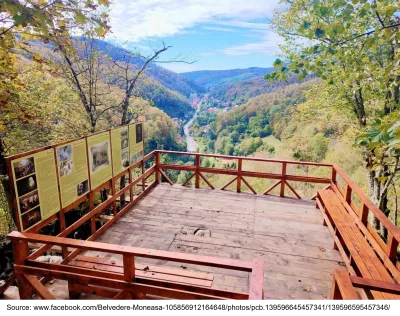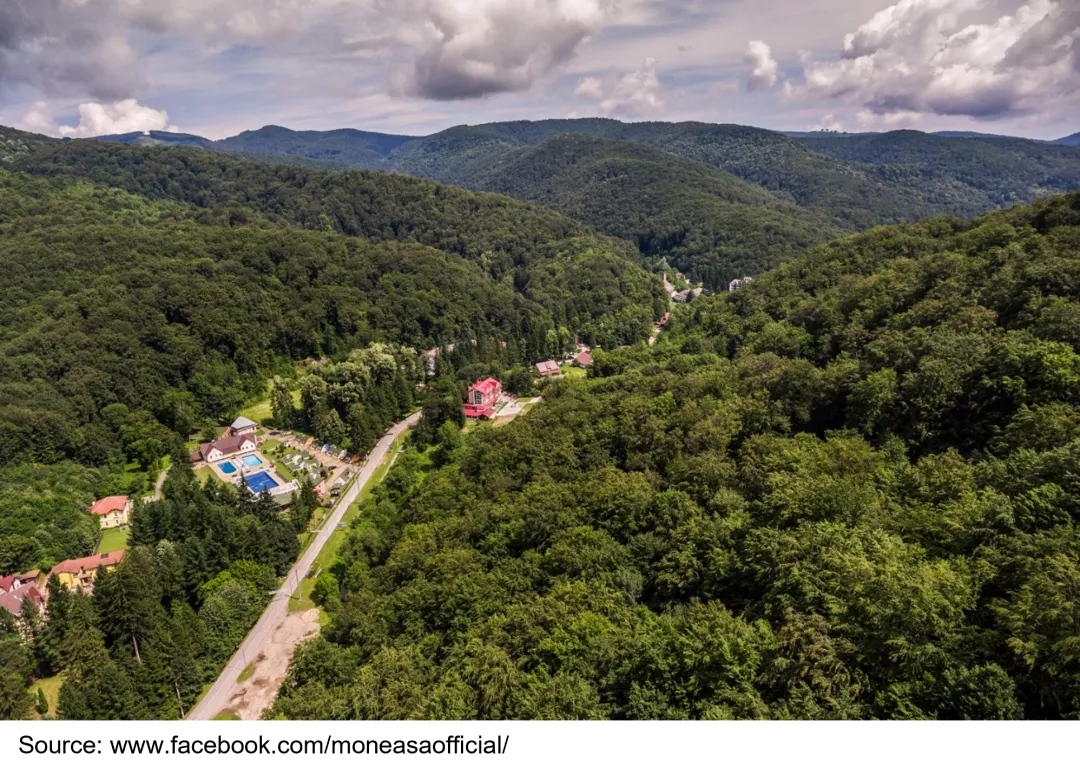General information
RDP Priority
- P4. Ecosystems management
RDP Focus Area
- 4A: Biodiversity restoration, preservation & enhancement
- 4B: Water management
- 4C: Soil erosion & soil management
RDP Measure
- M15: Forest-environment-climate
Summary
The Codru-Moma Massif is part of the Western Carpathian Mountains in Romania. Classified as a ‘forest with high conservation value’, it has been designated as a Natura 2000 site. It is publicly owned and managed by Moneasa Town Hall. To improve the forest management and monitoring of its unique ecosystem, an application was submitted under the rural development measure focusing on forest-environmental and climate commitments. The main project aims are to develop wildlife and reduce soil-damaging forest interventions.
In November 2020, 1 126 hectares of the Codru-Moma forest became part of a five-year intervention scheme compensating forest owners for income losses and costs incurred when applying new forest management methods. Key implementation activities include the creation of a 20 hectare quiet area for biodiversity conservation with limited commercial forestry activities permitted. A new regime for wood exploitation activities has also been established, according to sustainable forest management standards, outside the quiet area.
Results
At the mid-term point of the project, the project has achieved the following:
- Increased productive and protective capacity as well as growing conditions and general stability of the forest.
- Improved structural integrity and phytosanitary status of the forest area.
- Improvements in respecting the compliance of the wood exploitation activities.
- Increased knowledge and practices of local rangers and others involved in forestry work have been updated and improved.

Promoter
Moneasa Town Hall
Funding
Total budget 191 286 (EUR)
EAFRD 162 593 (EUR)
National/Regional 28 693 (EUR)
Sujets
Ressources
Documents
EU CAP Network - Good Practice - Moneasa, the beautiful mountain area of Codru Moma - Payments for forestry commitments
(PDF – 756.41 Ko)
Context
The Codru-Moma Massif of the Western Carpathian Mountains in Romania is classified as a ‘forest with high conservation value’. It is publicly owned consisting of beech, hornbeam, ash, and mountain ash, and valuable resinous species such as spruce, fir, and larch creating a unique and highly diverse ecosystem. The area has been designated as a Natura 2000 site and is included in the National Forest Fund.
The high biodiversity and conservation value of the Codru-Moma area requires conservation and this demands scientifically based monitoring and evaluation to ensure that its management is underpinned by appropriate scientific methods and supported accordingly.
The costs of such necessary research are high and were unaffordable for the small, local community of Moneasa, with only 636 inhabitants. However, Moneasa Town Hall (the administrative-territorial unit in charge of the forest) is a founding member of the local LEADER LAG and, through this engagement, the opportunity to access funding via the Romanian Rural Development Programme (RDP) 2014-2020 was identified. An application was prepared and submitted under sub-measure 15.1 of the RDP supporting forest-environmental and climate commitments. The bid was approved by APIA (the Payments and Interventions Agency for Agriculture in Romania) in November 2020 and 1 126ha of the Codru-Moma forest became part of a five-year aid and intervention scheme.
Objectives
The main project aims for Codru-Moma are twofold, including the creation of quiet areas for the development of wildlife and the reduction of the number of forest interventions. Therefore, multiple objectives are being pursued, such as increasing the stability of the Codru-Moma forest ecosystem by promoting wood exploitation technologies that have a low impact on the soil; reducing the periodicity of silvo-technical interventions; maintaining the consistency of arborets (small trees and shrubs); and ensuring that the financial loss of income and additional costs incurred by the new activities are covered via compensation over a period of five years.
The Codru-Moma intervention scheme and its multiple activities will help:
- Promote carbon capture.
- Adapt to the effects of climate change.
- Reduce soil erosion.
- Develop fauna that is specific to forest ecosystems.
- Improve the water retention capacity of the soils.
- Restore and conserve the local biodiversity.
Activities
For Codru-Moma, the five-year long financial support through the RDP is paid annually as a fixed amount per unit of the agreed surface area. There are two packages of support:
- Package 1 – Ensuring quiet areas - creating optimal conditions for nesting, shelter and feeding for the development of the fauna specific to the forest ecosystems.
- Package 2 – Promoting the increased use of extensive, low-impact technology for the exploitation of the wood.
Key activities included:
1. Preparing the funding application:
- Receiving approval from the local Council to access funding via RDP and for completing an inventory of the 1 127-ha large forest area.
- Elaborating a technical file by following the online applicants’ guide and receiving technical assistance from APIA and the County Forest Guard experts.
- Obtaining feedback and approval from the Oradea County Forest Guard for the technical file.
2. Submitting the application form in line with requirements.
3. Implementing the commitments:
- Implementing Package 1 (2021 and 2022): The delineation of a compact quiet area of 20 ha in size, setting plot boundaries and necessary forest access roads as agreed. In this area it is only permitted to execute afforestation work in support of natural regeneration, maintenance of crops and ecological reconstruction work.
- Implementing Package 2 (2023-2025): The exploitation activities of the forest (outside the quiet area) need to be executed according to the specifications of the grant agreement. This includes exclusively using trailers for the transport of wood material from thinning operations; limiting the thinning of trees to 0.3 cubic meters per tree on average; maintaining agreed distances for the collection of material.
- Communicating and documenting the specifications of the grant commitment with the contractors executing the forest works.
- Submitting annual payment claims.
- Reporting and verifying the activities performed by complying with the conditions of the grant commitment.
- Managing payments made to the beneficiary.
Main results
At the mid-term point of the project, the project has achieved the following:
- Increased productive and protective capacity and general stability of the forest.
- Improved structural integrity of the forest area.
- Creation of a 20-hectare quiet zone for biodiversity conservation.
- Improved phytosanitary status of the forest area, by gradually removing dry, broken, damaged, or defective trees and wood.
- Improvements in respecting the compliance of the wood exploitation activities undertaken in the designated area have been achieved.
- Improved growing conditions for the trees by reducing the density of the forest, for enhanced tree thickness and height, as well as an improved configuration of the crowns.
- Reduction of the initial administrative burdens and procedures for managing variations / changes regarding the execution of the forestry scheme.
- Increased knowledge and practices of local rangers and others involved in forestry work have been updated and improved.
- The new forest management approach is already noticeable to the community and tourists experiencing nature in the Codru-Moma forest in a new way.
- In the long-term, the scheme is expected to contribute to reducing greenhouse gas emissions, increasing the ecological capacity of the Codru-Moma forest and improving its capacity to adapt to climate change.
Key lessons and recommendations
- Most forests in Romania are actively utilised. Thus, protecting the natural environment through sustainable forest management and administration in line with EU-wide standards and rules is essential. Unfortunately, this is still too often neglected by forest managers.
- Maintaining an adequate proportion of herbaceous (non-woody) plants in forests contributes to reducing greenhouse gases, adapting to climate change and to increasing surface water retention.
- Maintaining flexibility and vision by the grant approving authorities are important, particularly when applicants face insurmountable gaps in data provision regarding the calculation of surface areas. A drive for simplification and efficiency at all stages (from application through to project completion) is considered essential for facilitating the implementation of necessary project activities.
- It is important that beneficiaries allow for sufficient time to adequately prepare the implementation of their projects and acquire additional knowledge if and when required.
“On the National Cleaning Day, together with the children from the ‘Gheorghe Groza’ Moneasa School, we participated in a greening action! We are all grateful for the beauty of Moneasa's nature and we need to be more aware of how important it is to protect and care for it!”
Doru Miron, Vice Mayor Moneasa
